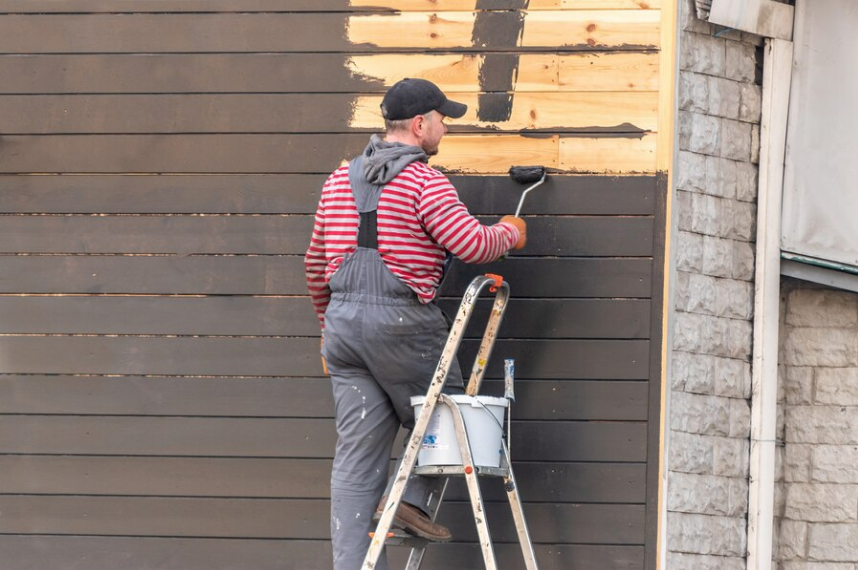Are you looking to give your home’s exterior a fresh new look? Painting the exterior of your home can be a great way to update its appearance and increase its curb appeal. However, painting your home’s exterior can also be a time-consuming and challenging task, especially if you’re not familiar with the painting process.
But don’t worry, with the right preparation and techniques, you can achieve a professional-looking finish that will last for years to come.
In this article, we’ll provide you with expert tips and advice on how to paint your home’s exterior from start to finish. We’ll cover everything from cleaning and preparing the surface to choosing the right paint and applying it using the right techniques.
By following these tips, you’ll be able to achieve a beautiful and long-lasting finish that will make your home the envy of the neighborhood. So let’s get started!

Cleaning the Surface: Removing Dirt and Debris
Before you start scrubbing away at the dirt and grime, it’s important to make sure the surface is completely clear of any debris.
The first step in preparing your home’s exterior for painting is to power wash the surface with a high-pressure washer. This will remove any loose dirt, debris, and peeling paint. Make sure to use the appropriate nozzle and pressure settings for your surface to avoid damaging the area you’re cleaning.
If there are any stubborn stains or areas with mold or mildew, you may need to use chemical cleaners. Be sure to read the instructions carefully and wear protective clothing and eyewear when using these products.
Apply the cleaner to the affected areas and let it sit for the recommended amount of time before rinsing it off with a hose.
Once you’ve thoroughly cleaned and cleared the surface, you’ll be ready to move on to the next step in the painting process.
Repairing Damage: Fixing Cracks and Holes
Patch up any cracks or holes in your walls like a surgeon using a needle and thread, creating a smooth canvas for your paint to glide over like a skater on ice.
Before filling in any cracks or holes, it’s important to assess the severity of the damage. For small cracks, you can use a flexible, paintable caulk, while larger cracks and holes may require a more heavy-duty filler.
There are various types of fillers available in the market, such as spackle, joint compound, and plaster. Choose the right type of filler based on the size and type of damage on your walls.
Once you’ve filled in the cracks and holes, let the filler dry completely. After it’s dry, sand it down until it’s smooth and even with the surrounding surface.
Matching textures is crucial to ensuring that the repair work blends in seamlessly with the rest of your exterior. If your wall has a stucco or textured finish, it’ll require a bit more effort to create a uniform texture.
You can use a texture spray or a trowel to recreate the texture, but make sure you practice on a small, inconspicuous area first to ensure that the texture matches the rest of the wall.
Remember, the goal is to create a smooth and even surface that’s ready for painting.
Priming the Surface: Ensuring Proper Adhesion
Now it’s time to ensure your paint will stick and last by priming the surface, giving you a smooth and even base for your final coat. Priming is a crucial step in the painting process, as it promotes adhesion between the surface and paint, prevents stains from bleeding through, and improves the overall appearance of the finish.
While there are priming alternatives available, such as self-priming paints or paint-and-primer-in-one products, it’s recommended to prime separately for the best results. When choosing a primer, consider the weather conditions in your area.
If you live in a humid or rainy climate, use a bonding primer that’s specifically formulated for moisture-prone surfaces. On the other hand, if you’re painting in hot and dry weather, choose a primer that can resist cracking and peeling caused by extreme temperatures.
Proper preparation and priming can make a significant difference in the longevity and overall quality of your exterior paint job.
Choosing the Right Paint: Color and Quality
Selecting the appropriate paint, taking into account color and quality, is an essential aspect of achieving a professional-looking finish for the exterior of your house.
Consider two paint types: oil-based or latex. Oil-based paints are durable and ideal for surfaces that are chalky or haven’t been painted in a long time. However, they can be challenging to clean up, have a strong odor, and take a longer time to dry.
On the other hand, latex paints are water-based, easy to clean up, and quick-drying. They are also more flexible and breathable, making them ideal for areas with high humidity.
When it comes to color matching, finding the perfect shade can be a daunting task. Before making a decision, take a look at your home’s style and surroundings, and choose a color that complements them. You can also take a sample of the paint and apply it on a small area of your home’s exterior to see how it looks in different lighting conditions.
Quality paint with a higher percentage of pigment and resin will last longer and provide better coverage, protecting your home against harsh weather conditions. Remember, choosing the right paint is crucial in achieving a durable and visually appealing finish that will increase your home’s curb appeal.
Painting Techniques: Rolling and Brushing for a Professional Finish
Let’s dive into the best techniques for achieving a professional finish on your house’s exterior by using a combination of rolling and brushing. When it comes to painting tools, it’s important to invest in high-quality rollers and brushes to ensure a smooth and even application.
A roller with a medium nap (around 3/8 inch) is best for most exterior surfaces, while brushes should be made of synthetic bristles for durability and ease of cleaning.
Surface texture is also an important consideration when it comes to painting techniques. For smooth surfaces, such as stucco or siding, a roller is the best choice for applying the majority of the paint. However, for textured surfaces like brick or stone, a combination of rolling and brushing is necessary to ensure the paint gets into all the crevices and contours.
Use a brush to ‘cut in’ around corners and edges, then switch to a roller to cover the larger areas. With a little bit of practice and attention to detail, you’ll be able to achieve a professional-looking finish on your home’s exterior.
Frequently Asked Questions
How long should I wait before painting after pressure washing the exterior of my home?
Are you itching to get started on painting your home’s exterior after a good pressure washing? Hold your horses! You need to wait at least 48 hours for the surface to dry completely. If you don’t wait, you’ll end up with a paint job that won’t last as long as it should.
And speaking of pressure washing, while it’s a great way to prep your home for painting, be careful not to damage the surface with too much pressure or by holding the nozzle too close. If you’re not comfortable doing it yourself, consider hiring a professional who has the expertise in pressure washing techniques and can ensure your home is prepped properly for a long-lasting paint job.
What is the best way to remove old paint before starting a new paint job?
To remove old paint before starting a new paint job, there are two main methods: using chemical strippers or sanding techniques. Chemical strippers work by breaking down the bond between the old paint and the surface, making it easier to scrape off. However, it’s important to follow safety precautions as these strippers can be hazardous to your health if not used properly.
Sanding techniques involve using sandpaper or a sanding machine to remove the old paint layer by layer until you reach the bare surface. This method requires more physical work and can create a lot of dust, so it’s important to wear protective gear and work in a well-ventilated area.
Ultimately, the best method for removing old paint depends on the type of surface and the condition of the old paint. A professional painter can help determine the best approach for your specific project.
Can I mix different brands of paint for my exterior job?
Mixing different brands of paint is like trying to fit a square peg into a round hole – it’s not always a perfect match. Paint brand compatibility is a crucial aspect of exterior painting that can be overlooked by many.
Although mixing different brands of paint is possible, it can affect the longevity and overall appearance of the final product. Color matching is also a critical factor to consider when mixing paints as various brands may have slight color variations.
To ensure a high-quality finish, it’s best to stick to one brand of paint and color match it precisely for your exterior job. As an expert in painting techniques, attention to detail is key to achieving a beautiful end result.
What is the best type of paint to use for extreme weather conditions?
When it comes to extreme weather conditions, it’s important to choose a durable paint option with a weather-resistant finish. Look for paints that are specifically designed for harsh outdoor environments, like those with added UV protection or moisture resistance.
High-quality acrylic or elastomeric paints are great choices for their ability to expand and contract with temperature changes, preventing cracking and peeling.
Don’t skimp on the prep work either – ensuring a clean and smooth surface before painting will help your weather-resistant finish last longer.
Investing in the right paint and taking the time to properly prepare your exterior surfaces will ensure your home stays protected from the elements for years to come.
Should I cover my landscaping before starting an exterior paint job?
Protecting your landscaping before starting an exterior paint job is like putting on sunscreen before hitting the beach—it’s a crucial step that will save you from regret later on.
To ensure that your plants, flowers, and bushes are not damaged during the painting process, it’s recommended to cover them with protective materials such as plastic sheeting and drop cloths. This will prevent paint splatters, debris, and dust from settling on your landscaping and causing harm.
In addition to landscaping protection, it’s important to have the right equipment such as a pressure washer and a paint sprayer. By taking these precautions, you can rest assured that your landscaping will remain healthy and vibrant throughout the painting process.
In this article, we’ll be discussing the top five most common home repairs and how to handle them like a pro.
Conclusion
Congratulations! You’ve successfully transformed your home’s exterior from drab to fab! Your neighbors will be green with envy as they pass by your freshly painted abode.
You’ve taken the necessary steps to ensure a professional finish that’ll last for years to come. By thoroughly cleaning the surface, repairing any damage, priming the surface, choosing the right paint, and implementing proper painting techniques, you’ve achieved a stunning result.
You’ve proven to be an expert in painting techniques, displaying your knowledge and attention to detail throughout the process. Your home’s exterior is a reflection of your personal style and taste, and you’ve undoubtedly made a bold statement with your color choice and quality of paint.
You can rest easy knowing that your home is not only beautiful, but also protected from the elements. In conclusion, painting your home’s exterior can be a daunting task, but with proper preparation and technique, you can achieve a stunning result that’ll make you the envy of the neighborhood.
So go ahead, pat yourself on the back, and enjoy your newly transformed home!

